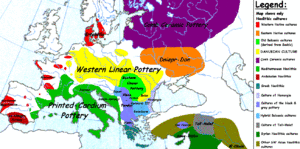Dnieper–Donets culture facts for kids
 |
|
| Geographical range | North of the Black Sea |
|---|---|
| Dates | c. 5000 BC – 4200 BC |
| Preceded by | Bug–Dniester culture |
| Followed by | Sredny Stog culture |

The Dnieper–Donets culture was an ancient group of people who lived north of the Black Sea. They existed from about 5000 BC to 4200 BC. This culture started in the Mesolithic (Middle Stone Age) and continued into the Neolithic (New Stone Age). They were known for their unique way of life and how they buried their dead. Later, the Sredny Stog culture followed them.
Contents
Discovering the Dnieper–Donets Culture
The Dnieper–Donets culture was first identified by a Soviet archaeologist named Dmytro Telehin. He did this in 1956, based on ideas from another archaeologist, Valentyn Danylenko. Dmytro Telehin worked at the Institute of Archaeology in Ukraine. In 1967, he completed his important research on this culture.
Where and When They Lived
The Dnieper–Donets culture began around 5800 BC. It quickly grew and spread across a large area. By 5200 BC, a new phase of the culture, called Dnieper–Donets II, began. This later period lasted until about 4200 BC.
These people lived in the wide, open grasslands (called steppes) and the areas where forests met grasslands, just north of the Black Sea. Over time, their population grew, and they moved further into the steppe regions.
The Dnieper–Donets culture had connections with other groups living nearby. They shared similarities with the Samara culture to the north and the Khvalynsk culture and Sredny Stog culture to the east. This suggests that these cultures might have traded or interacted a lot.
How They Lived
Homes and Settlements
Archaeologists have found over 200 sites related to the Dnieper–Donets culture. Not many of their actual homes have been found. However, some semi-underground huts, covered with tree bark, have been discovered.
What They Ate and How They Lived
At first, the Dnieper–Donets people were hunter-gatherers. This means they hunted wild animals and collected plants for food. They hunted animals like aurochs (a type of wild cattle), elk, red deer, and wild boar. They also ate fish and nuts. Their diet was mostly rich in protein from meat and fish.
Around 5200 BC, they started keeping animals like cattle, sheep, and goats. They also had pigs, horses, and dogs. These domestic animals slowly spread east towards the Volga and Ural mountains. Some experts think that around 4200 BC, they also began farming crops like millet, wheat, and pea. However, there isn't much clear proof of them farming widely. They also traded with people from the Caucasus region, getting special items like copper.
Art and Tools
The Dnieper–Donets people did not make female figurines, which were common in some other cultures of that time. They used tools that were similar to those from the Middle Stone Age. Later, they started using polished stone axes and flint tools. These tools were sometimes buried with the dead.
Pottery
Their early pottery had pointed bottoms. Later, they made pottery with flat bottoms. Their pottery looked very different from the pottery made by the nearby Cucuteni–Trypillia culture. Pottery became more important over time, suggesting they started living in one place for longer periods. The unique shape of their early pottery might have been useful for carrying things in boats in wet areas.
Burial Customs
The Dnieper–Donets culture is famous for its cemeteries. About thirty of these burial sites have been found, some of them very large. One type, called Mariupol cemeteries, held around 800 people! It seems that funerals were very important and involved many steps.
People were often buried in large pits. Their bodies were sometimes covered with red ochre (a natural pigment). In some cases, bodies might have been left out for a while before their bones were collected and buried. However, most people were buried whole. Sometimes, only skulls were buried, but usually, the whole body was. Animal bones were also found in the graves.
Some Dnieper–Donets burials included special items like copper ornaments, crystal, shell beads, and polished stone maces. These items, along with the careful burial methods, suggest that these people had power or high status. Even some children were buried with such items, which means that wealth or status could be passed down in their families. Similar items have been found in graves of the Samara culture, showing connections between these groups.
Successors
The Dnieper–Donets culture eventually merged with or was taken over by the Sredny Stog culture, which was their neighbor to the east. Both the Dnieper–Donets and Sredny Stog cultures were later followed by the Yamnaya culture. Other cultures like the Mikhaylovka culture also show signs of continuing traditions from the Dnieper–Donets people.
Images for kids
See also
- Deriivka
- Catacomb culture
- Comb Ceramic culture
- Narva culture
- Pitted Ware culture
- Rzucewo culture


